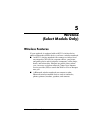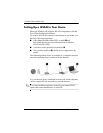
Wireless (Select Models Only)
Hardware and Software Guide 5–3
802.11 Wireless Devices
(Select
Models Only)
With an 802.11 wireless device, you can access a wireless local
area network (commonly referred to as wireless network, wireless
LAN, or WLAN), which is composed of other computers and
accessories linked by a wireless router or a wireless access point.
■ A large-scale WLAN, such as a corporate or public WLAN,
typically uses wireless access points that can handle a large
number of computers and accessories and can separate
critical network functions.
■ A home or small office WLAN typically uses a wireless
router, which enables several wireless and wired computers
to
share an Internet connection, a printer, and files without
additional pieces of hardware or software. The terms
wireless
access point and wireless router are often used
interchangeably.
There are 3 popular implementations of 802.11 wireless devices:
■ 802.11b
■ 802.11b/g
■ 802.11a/b/g
Computers with 802.11 wireless devices may support 1 or more
of 3 industry standards:
■ 802.11b, the first popular standard, supports data rates of up
to 11 Mbps and operates at a frequency of 2.4 GHz.
■ 802.11g supports data rates of up to 54 Mbps and operates at
a frequency of 2.4 GHz. An 802.11g WLAN device is
backward compatible with 802.11b devices, so they can
operate on the same network.
■ 802.11a supports data rates of up to 54 Mbps and operates at
a frequency of 5 GHz. 802.11a is not compatible with
802.11b and 802.11g.
For information on identifying the type of wireless device in your
computer, refer to “Identifying an 802.11 Wireless Device.”


















